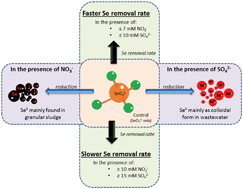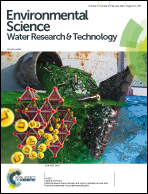Effect of elevated nitrate and sulfate concentrations on selenate removal by mesophilic anaerobic granular sludge bed reactors†
Abstract
Simultaneous removal of selenate (SeO42−), nitrate (NO3−) and sulfate (SO42−), typically present in Se-contaminated wastewaters, by Eerbeek anaerobic granular sludge, was investigated in batch and continuous bioreactor experiments. Batch experiments showed that SeO42− removal was enhanced to 91% in simulated wastewater with SeO42− + NO3− + SO42− (1 : 40 : 100 SeO42− : NO3− : SO42− molar ratios) compared to simulated wastewater with SeO42− alone (67%). SeO42− removal was severely impacted by high concentrations of SO42− (SeO42− : SO42− > 1 : 300). Removal of SeO42−, NO3− and SO42− at a 1 : 40 : 100 ratio was studied in a 2 L lab-scale upflow anaerobic sludge blanket (UASB) reactor operated at 20 °C, a 24 h hydraulic retention time and a 2 g COD L−1 day−1 organic loading rate using lactate as the electron donor. The removal efficiencies were stabilized at 100, 30 and 80% for NO3−, SO42− and total Se, respectively, during 92 days of UASB operation. The total Se removal efficiencies dropped to 47% or even to a negative value when, respectively, SO42− and NO3− were sequentially excluded from the influent. Speciation of Se, particularly the microbial production of colloidal Se0 levels, was influenced by both SO42− and NO3−. The results presented here demonstrate that UASB reactors are capable of removing SeO42− in the presence of millimolar concentrations of NO3− and SO42− typically found in Se-contaminated wastewaters.

- This article is part of the themed collection: Best Papers 2018 – Environmental Science: Water Research & Technology


 Please wait while we load your content...
Please wait while we load your content...